run flat TOYOTA IQ 2012 Owners Manual
[x] Cancel search | Manufacturer: TOYOTA, Model Year: 2012, Model line: IQ, Model: TOYOTA IQ 2012Pages: 476, PDF Size: 23.52 MB
Page 388 of 476
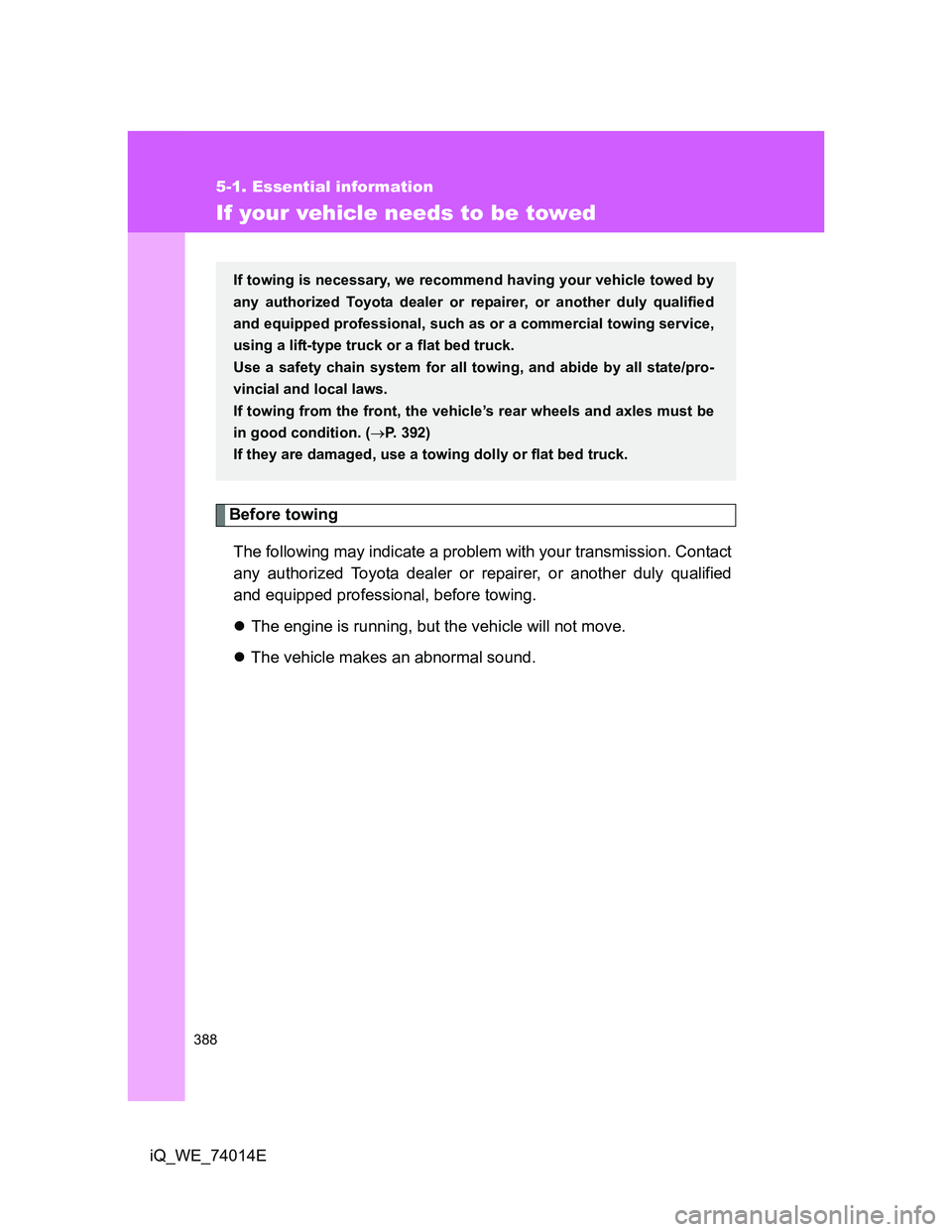
388
5-1. Essential information
iQ_WE_74014E
If your vehicle needs to be towed
Before towing
The following may indicate a problem with your transmission. Contact
any authorized Toyota dealer or repairer, or another duly qualified
and equipped professional, before towing.
The engine is running, but the vehicle will not move.
The vehicle makes an abnormal sound.
If towing is necessary, we recommend having your vehicle towed by
any authorized Toyota dealer or repairer, or another duly qualified
and equipped professional, such as or a commercial towing service,
using a lift-type truck or a flat bed truck.
Use a safety chain system for all towing, and abide by all state/pro-
vincial and local laws.
If towing from the front, the vehicle’s rear wheels and axles must be
in good condition. (P. 392)
If they are damaged, use a towing dolly or flat bed truck.
Page 390 of 476
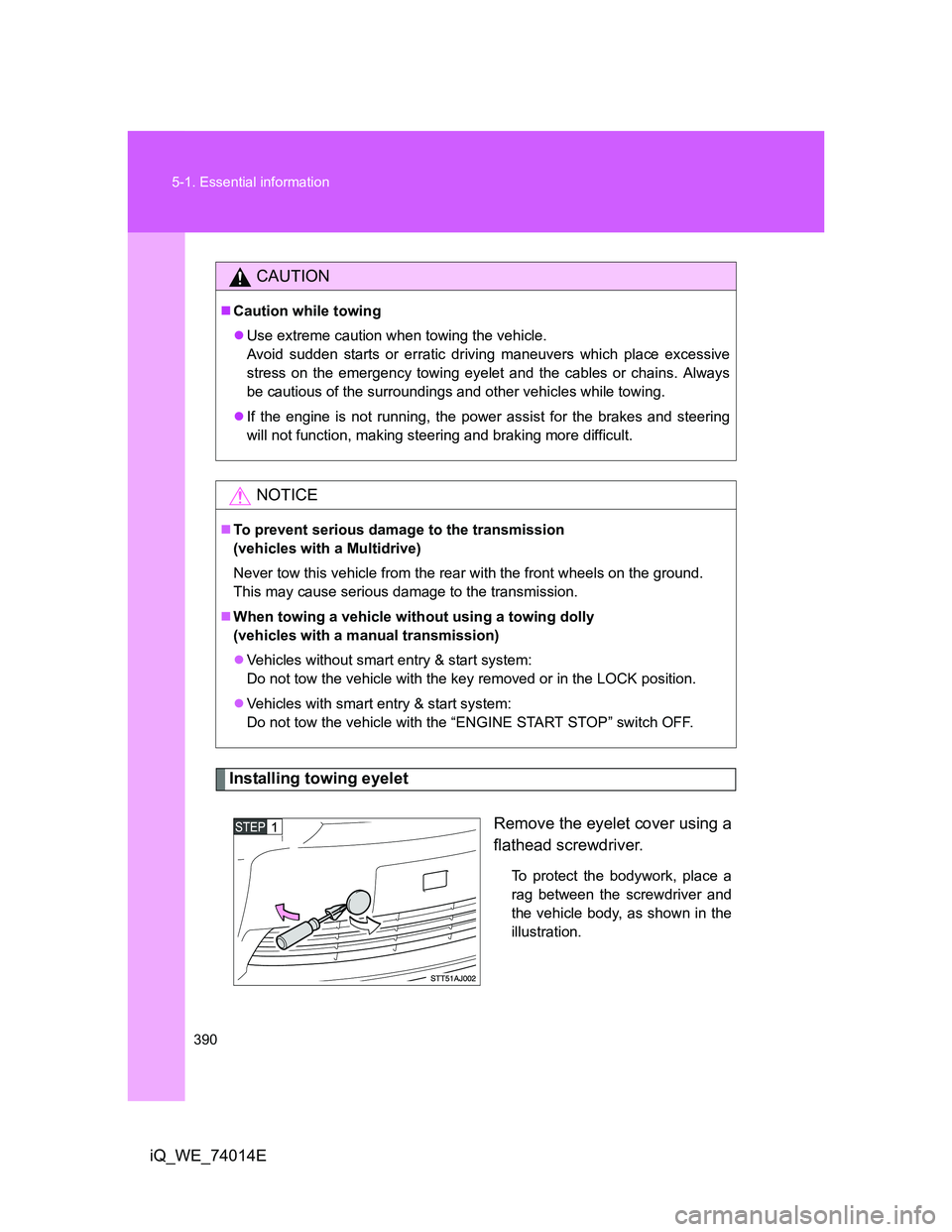
390 5-1. Essential information
iQ_WE_74014E
Installing towing eyelet
Remove the eyelet cover using a
flathead screwdriver.
To protect the bodywork, place a
rag between the screwdriver and
the vehicle body, as shown in the
illustration.
CAUTION
Caution while towing
Use extreme caution when towing the vehicle.
Avoid sudden starts or erratic driving maneuvers which place excessive
stress on the emergency towing eyelet and the cables or chains. Always
be cautious of the surroundings and other vehicles while towing.
If the engine is not running, the power assist for the brakes and steering
will not function, making steering and braking more difficult.
NOTICE
To prevent serious damage to the transmission
(vehicles with a Multidrive)
Never tow this vehicle from the rear with the front wheels on the ground.
This may cause serious damage to the transmission.
When towing a vehicle without using a towing dolly
(vehicles with a manual transmission)
Vehicles without smart entry & start system:
Do not tow the vehicle with the key removed or in the LOCK position.
Vehicles with smart entry & start system:
Do not tow the vehicle with the “ENGINE START STOP” switch OFF.
Page 395 of 476
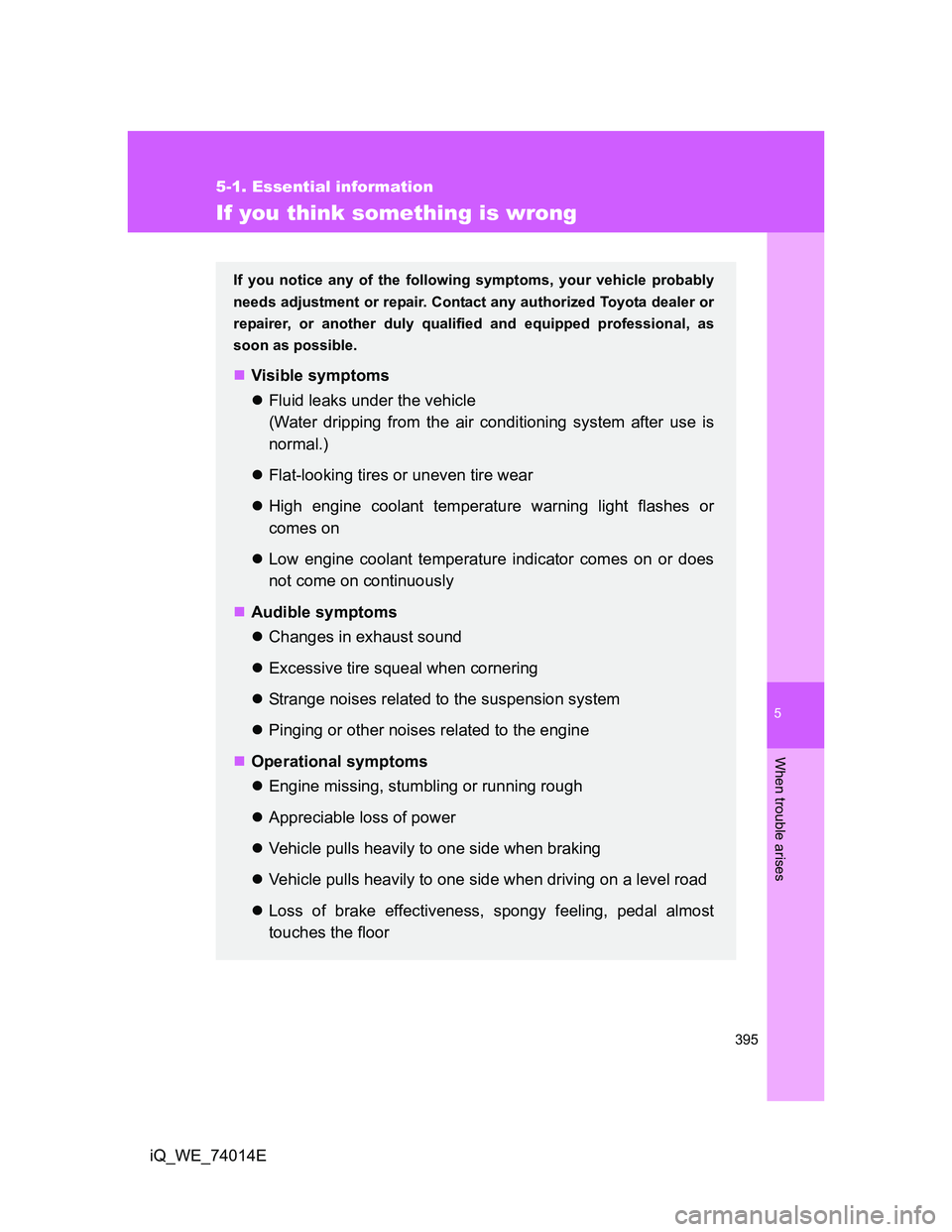
5
395
5-1. Essential information
When trouble arises
iQ_WE_74014E
If you think something is wrong
If you notice any of the following symptoms, your vehicle probably
needs adjustment or repair. Contact any authorized Toyota dealer or
repairer, or another duly qualified and equipped professional, as
soon as possible.
Visible symptoms
Fluid leaks under the vehicle
(Water dripping from the air conditioning system after use is
normal.)
Flat-looking tires or uneven tire wear
High engine coolant temperature warning light flashes or
comes on
Low engine coolant temperature indicator comes on or does
not come on continuously
Audible symptoms
Changes in exhaust sound
Excessive tire squeal when cornering
Strange noises related to the suspension system
Pinging or other noises related to the engine
Operational symptoms
Engine missing, stumbling or running rough
Appreciable loss of power
Vehicle pulls heavily to one side when braking
Vehicle pulls heavily to one side when driving on a level road
Loss of brake effectiveness, spongy feeling, pedal almost
touches the floor
Page 455 of 476
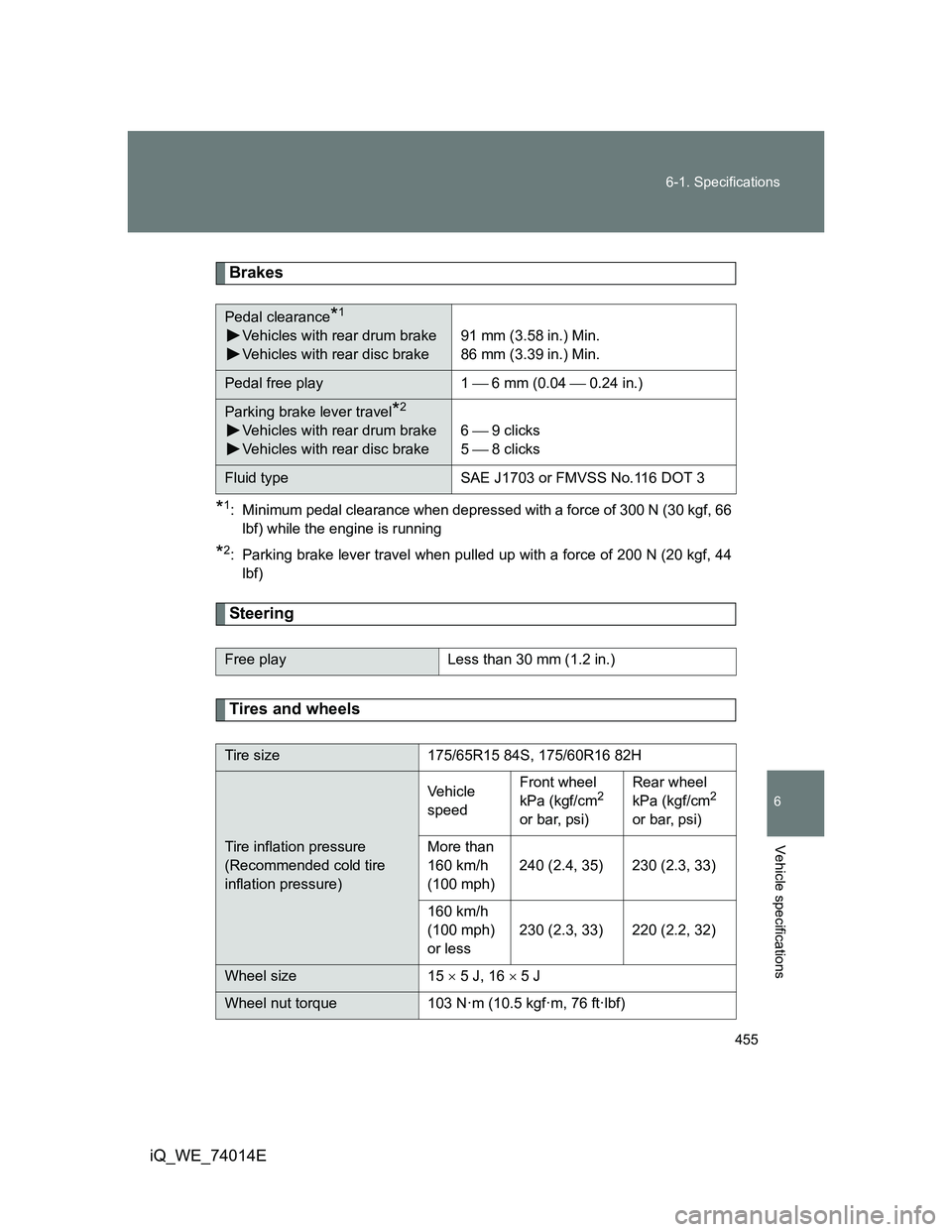
455 6-1. Specifications
6
Vehicle specifications
iQ_WE_74014E
Brakes
*1: Minimum pedal clearance when depressed with a force of 300 N (30 kgf, 66
lbf) while the engine is running
*2: Parking brake lever travel when pulled up with a force of 200 N (20 kgf, 44
lbf)
Steering
Tires and wheels
Pedal clearance*1
Vehicles with rear drum brake
Vehicles with rear disc brake91 mm (3.58 in.) Min.
86 mm (3.39 in.) Min.
Pedal free play 1 6 mm (0.04 0.24 in.)
Parking brake lever travel*2
Vehicles with rear drum brake
Vehicles with rear disc brake6 9 clicks
5 8 clicks
Fluid type SAE J1703 or FMVSS No.116 DOT 3
Free play Less than 30 mm (1.2 in.)
Tire size 175/65R15 84S, 175/60R16 82H
Tire inflation pressure
(Recommended cold tire
inflation pressure)Vehicle
speedFront wheel
kPa (kgf/cm
2
or bar, psi)Rear wheel
kPa (kgf/cm2
or bar, psi)
More than
160 km/h
(100 mph)240 (2.4, 35) 230 (2.3, 33)
160 km/h
(100 mph)
or less230 (2.3, 33) 220 (2.2, 32)
Wheel size 15 5 J, 16 5 J
Wheel nut torque 103 N·m (10.5 kgf·m, 76 ft·lbf)
Page 471 of 476
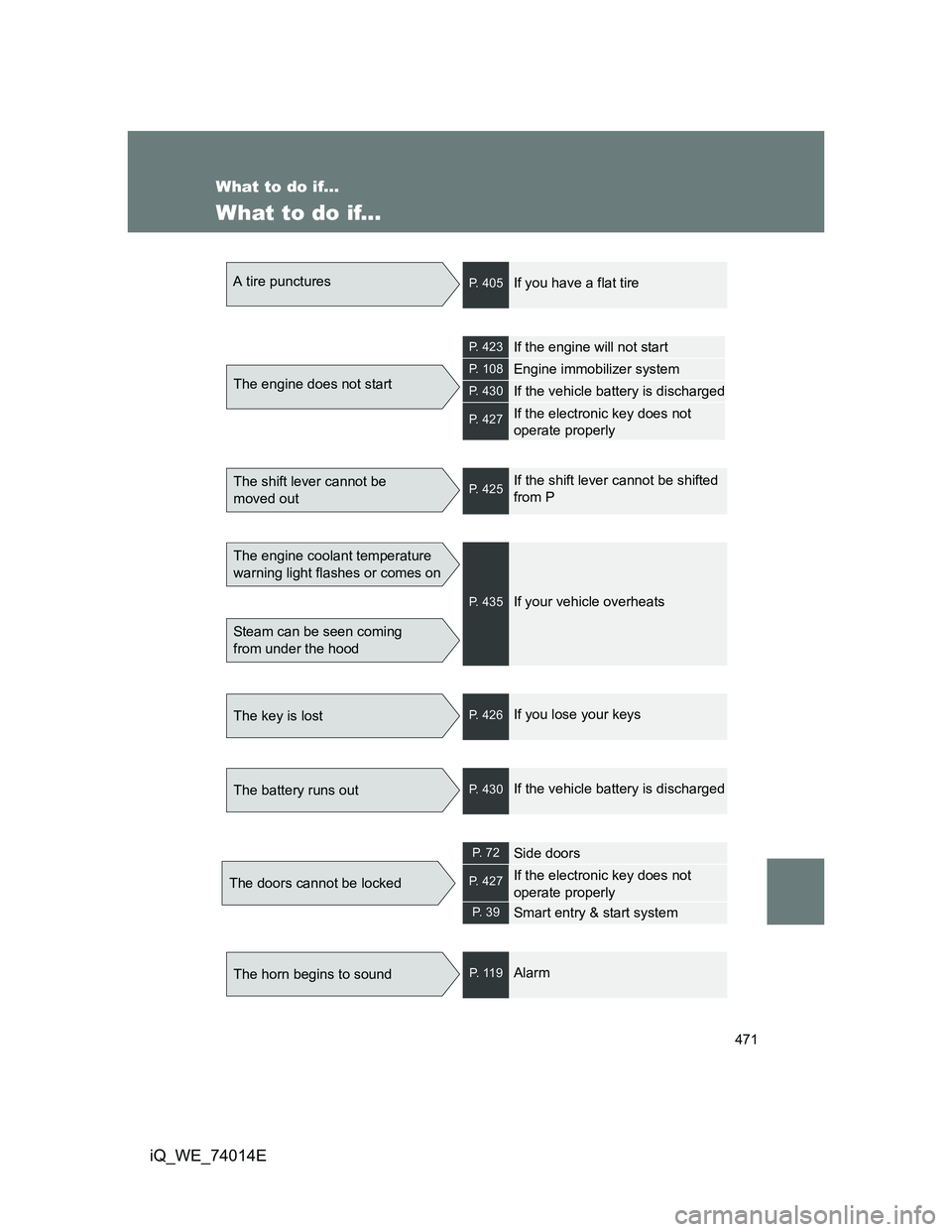
471
iQ_WE_74014E
What to do if...
What to do if...
A tire puncturesP. 405If you have a flat tire
The engine does not start
P. 423If the engine will not start
P. 108Engine immobilizer system
P. 430If the vehicle battery is discharged
P. 427If the electronic key does not
operate properly
The shift lever cannot be
moved outP. 425If the shift lever cannot be shifted
from P
The engine coolant temperature
warning light flashes or comes on
Steam can be seen coming
from under the hood
P. 435If your vehicle overheats
The key is lostP. 426If you lose your keys
The battery runs outP. 430If the vehicle battery is discharged
The doors cannot be locked
P. 7 2Side doors
P. 427If the electronic key does not
operate properly
P. 3 9Smart entry & start system
The horn begins to soundP. 1 1 9Alarm